These days, it seems like more gun companies have put more focus on the speed of production rather than producing a quality firearm. But there was a time when gunsmiths crafted each individual firearm for a specific owner, a bespoke product of the craft with an impeccable fit and finish that someone would be proud to hand down to their children one day. In that tradition, Henry Repeating Arms started producing the Henry Original Rifle this year, a reincarnation of the Model 1860 lever action rifle that first went into production the year that the American Civil War started . . .
Over 1,700 of the original rifles were purchased for use in the war between the states, but advancements in metallurgy and cartridge design quickly made the Model 1860 obsolete. By 1866 the Winchester Arms Company had stopped production of the firearm and the U.S. Army’s preference for single shot rifles in heavy-hitting calibers put the final nail in the coffin of the pistol-caliber Model 1860. The brass-based beauty would be resurrected by Uberti in Italy and imported into the United States, but even their efforts were nowhere near the level of Henry’s original offering.
From the first time I took the rifle out of its box, I knew that it was something special. I had asked Anthony Imperato, the owner of Henry Repeating Arms, to send me a .45-70 lever action to test out — a workhorse rifle with a hunting background — so imagine my surprise when the first thing that I saw was a presentation quality wood grain stock.
I just want to salivate over that stock for a few more seconds. The last time I hadn’t seen wood of this quality since I was sitting in Holland & Holland’s New York City gun room and fondling $20,000 shotguns. But the Henry handiwork gives them a run for their money.
Not only is the stock devastatingly beautiful, the fit and finish are amazing. The wood is perfectly shaped to meet the brass receiver, leaving no gaps or ridges. And the brass buttplate and receiver tang are recessed into the stock in such a way that it looks like they were painted on after the stock was finished. Running your hand over the finely sanded and stained wood feels like stroking a satin bedspread and resting your cheek on the stock is like putting it on a pillow. It’s just perfect.
The receiver on the Henry Original is made from a solid chunk of hardened brass, then polished to the point where any glimmer of light whatsoever completely washes out the picture on your camera. The surface of the receiver came beautifully clean and polished from the factory, but after only a few minutes of handling the gun was filled with fingerprints. Thankfully, the kind folks at Henry include a black cloth that is designed to go around the receiver and polish it back to its original luster and protect it when not in use.
The Model 1860 was designed in an era when repeating firearms were still new, and no one had really figured out how to make the damned things work right. John Browning’s designs were still decades away and so the gunsmiths of the time were improvising and finding dozens of ways to accomplish the same thing — ending up with some of the overly-complicated design we see today. If you’ve ever watched an Orangutan try to work on a Ford Model T, it’s kind of the same principle. All of the parts are there, but the mechanism is overly complicated and seems built for failure.
Take the loading mechanism for example. Everything happens along the top of the receiver, with the bolt pulling the spent cartridge out of the chamber and then the lifter rising up like two golden hands presenting the holy .44-40 Winchester Cartridge for loading into the breech. It’s a beautiful system and very aesthetically pleasing, but it relies on the bullets being perfectly round and perfectly seated to work — any minor imperfections and the gun starts to jam. Throw a little dirt and grime into the system and it starts behaving more like the prima donna it appears to be.
Keeping those bullets perfectly seated is a challenge, especially with the magazine mechanism.
While later models of lever action rifles would be loaded from the breech, the Henry Model 1860 uses a unique magazine system. The follower (also made of a piece of beautiful hardened brass with an orange high-visibility head) has a tab that protrudes from the bottom of the gun. To load the rifle, the shooter moves that follower along the slotted track until it retracts into the top of the tube. From there, the top portion actually pivots to the right and reveals the magazine tube. The shooter then loads the rounds one by one, dropping them in the tube magazine and letting gravity move them to the bottom of the slot. When full, the shooter pivots the follower back into position and releases it.
There are two issues with this system. First, that initial round you load into the gun will be hammered by each successive round you load and will have its projectile seated further inside the cartridge as a result. If the bullet goes too far inside, the gun will fail to properly load and will jam. Or, if you just release the follower, the bullet of the top cartridge will be hammered back into the case and the same thing will happen. In other words, no bueno. Second, the follower has a rather large tab that protrudes from the bottom of the gun and moves with the bullets. So if your hand gets in the way, the follower won’t work and the gun will jam. And don’t even get me started about the open magazine design and the lessons we learned from the Chauchat.
There’s no doubt that the design is fascinating, and it’s a great milestone in firearms engineering, but you can see why people preferred the closed magazine with a loading gate instead.
Moving on, the sights are somewhat interesting. The rifle has a ladder rear sight (that folds down for a standard set of open sights), and a silver blade front sight. Shiny front sights like these are standard fare for fine firearms, and Holland & Holland use actual silver on their front sights as well, but in the shiny Texas sunlight things tend to get a bit washed out. Picking up the front sight was difficult in the bright daylight on a dirt background, but against trees or other colored targets (like, say, deer) this should do well.
Speaking of shooting, the gun is an absolute dream to fire.
The rifle is chambered in .44-40 Winchester, a relatively light pistol load that (according to Wikipedia) is second only to the .30-30 as having the most deer kills on record. The result of using such a light kicking load in a long and heavy rifle such as this is that recoil is downright pleasant, only a mild push instead of the harsh kick that comes with the .45-70 Government.
Everything about the firing process is excellent. The action is crisp and responsive, making loading the rifle extremely easy. The trigger is as crisp as a glass rod breaking, and the blade of the trigger is finely polished and feels very nice against your trigger finger. Even the hammer has been sculpted and polished to perfection. It’s a delightful firearm that I’ve truly enjoyed playing with on the range.
When it comes to this review, I’m conflicted. As a firearm design, the gun has some glaring issues — which is why it didn’t see much usage and was discontinued pretty quickly. But as a reproduction and a historical piece, this firearm is amazing. The fit and finish, along with the near perfect mechanics of the gun make it stand out among the crowd as something truly special.
Original Henry Rifle (Model 1860)
Specifications:
Caliber: .44-40 Winchester
Barrel: 24 inches
Size: 43 inches
Weight: 9 lbs empty
Capacity: 13 + 1
MSRP: $2,300
Ratings (Out of Five Stars):
All ratings are relative compared to the other weapons in the gun’s category.
Accuracy: * * * * *
For a pistol caliber lever action rifle, it shot remarkably well. Probably not a 100+ yard gun, but ver nice nevertheless.
Ergonomics: * * *
The magazine follower brought back some unpleasant memories of a freezing cold night I spent in a trench with a DP-28 machine gun. Which explains my distaste for reciprocating charging handles. That, plus there’s a tab that keeps the action closed when in storage and I got my hand caught in it when cycling the action. It caused a pretty nasty bruise.
Ergonomics Firing: * * * * *
Recoil is downright enjoyable, the trigger is nearly perfect and the hammer is easy to manipulate.
Customization:
Uh…no.
Overall Rating: * * * *
While the gun itself is only “meh” even compared to other lever action rifles, it’s the quality of the reproduction that we care about here. In that sense, this is a fantastic firearm that shows superb craftsmanship and attention to detail. I dropped one star because the Uberti reproduction looks pretty good, too, but costs almost $1,000 less.

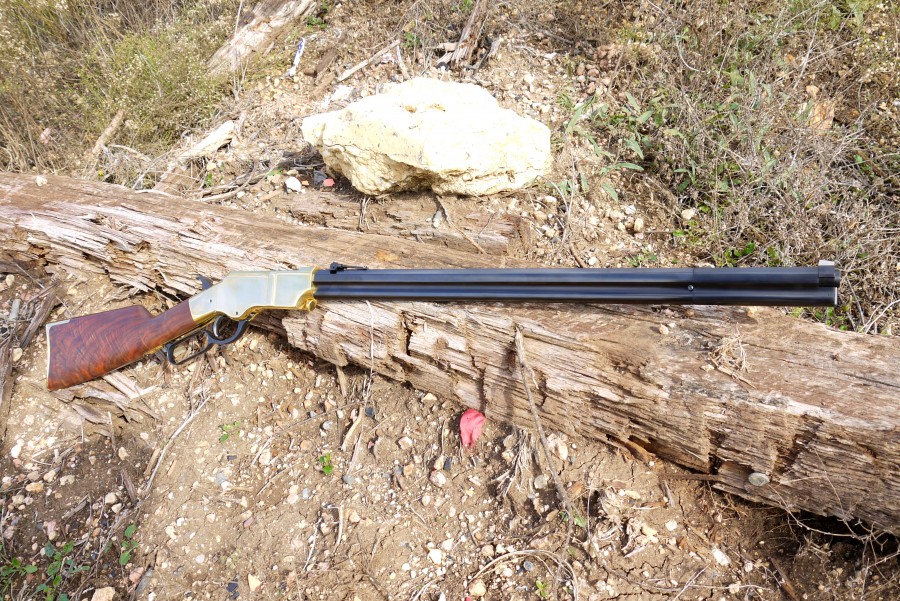
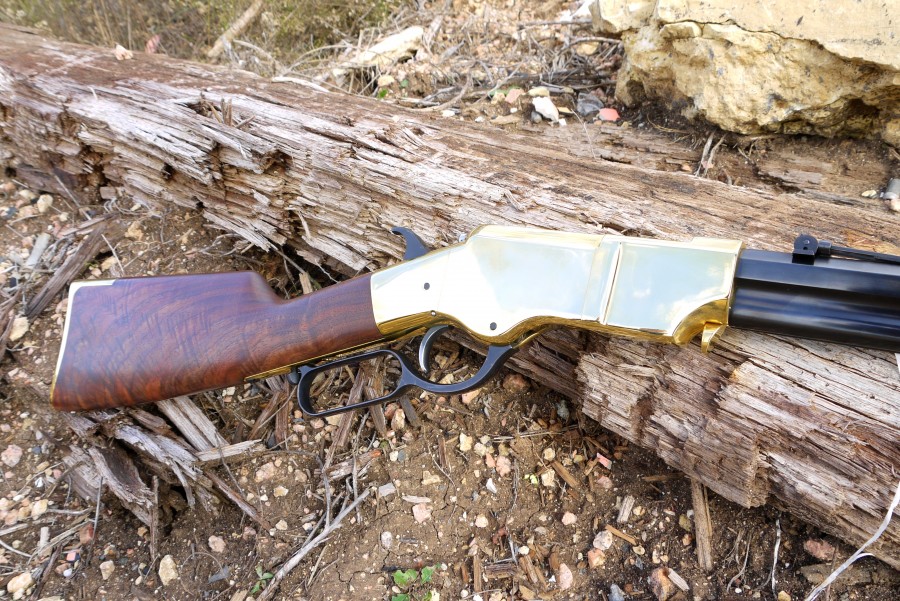
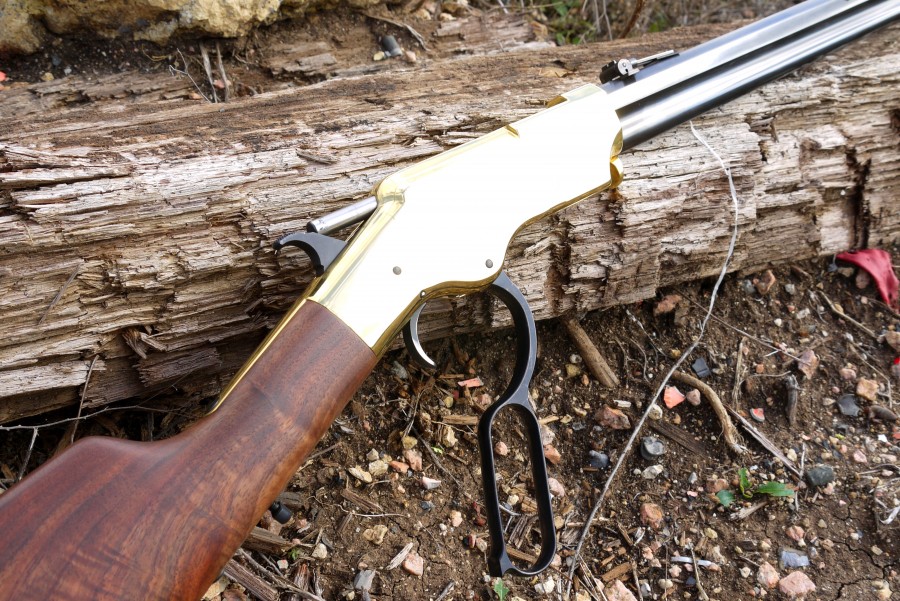
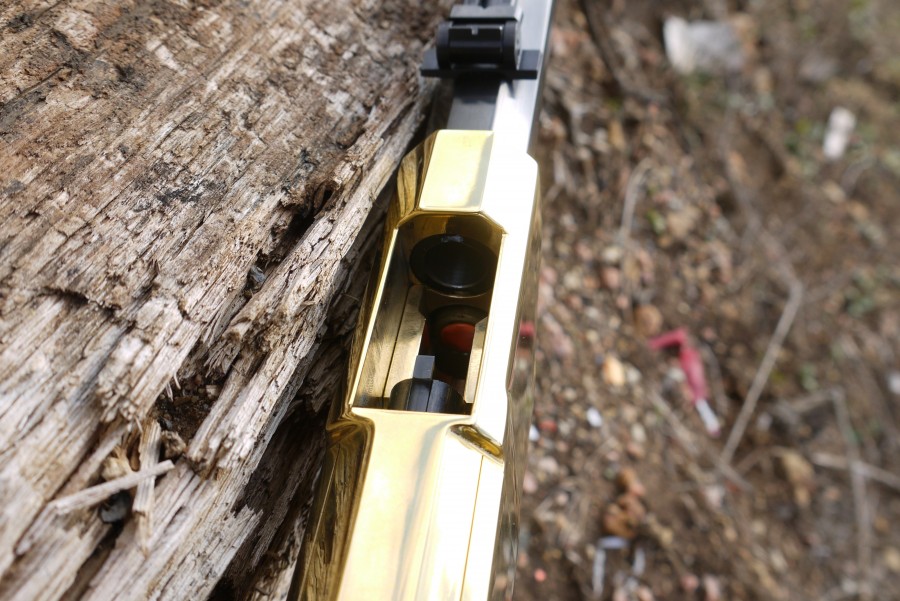
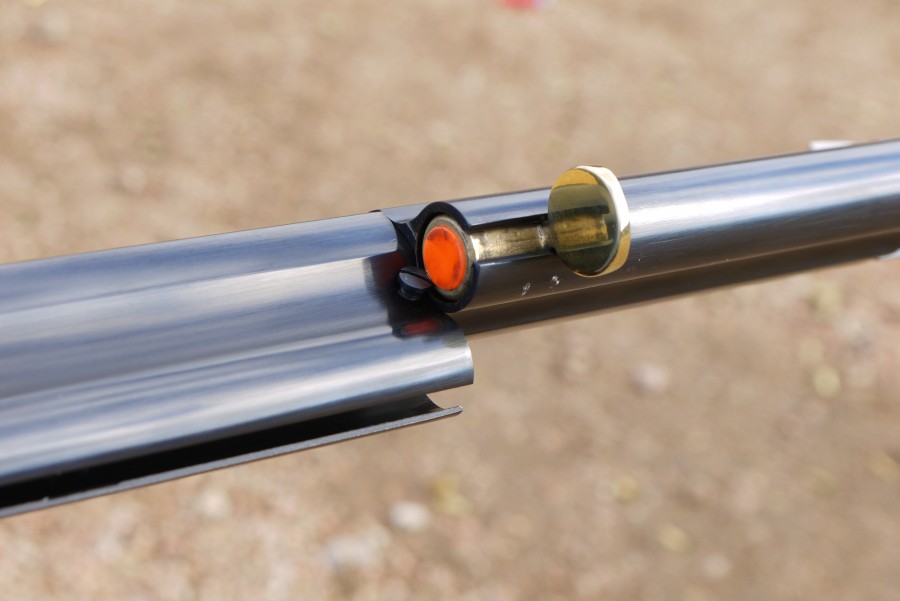

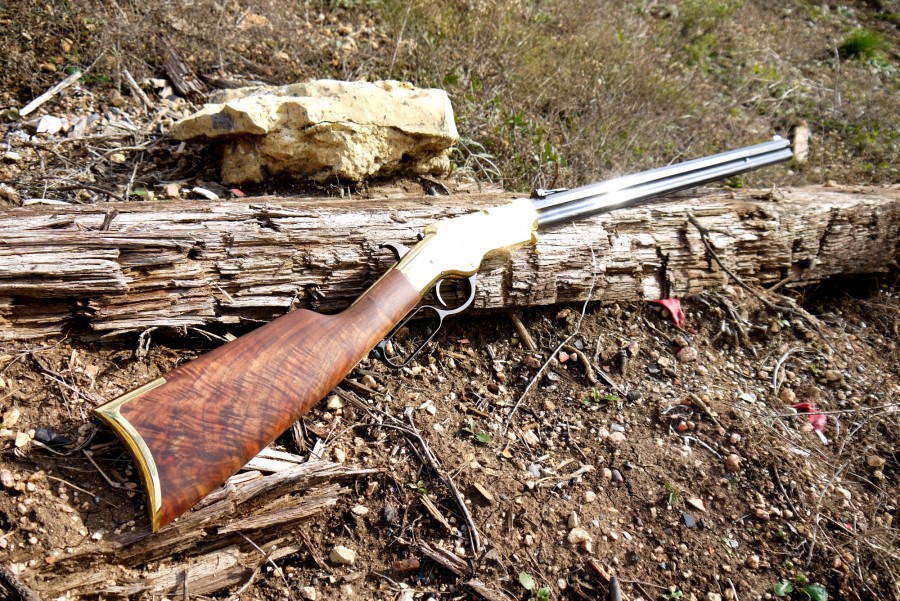



I hope my wife doesnt catch me gawking at this gun porn.
Made in New Jersey? I’d rather buy American. (sarc on)
Could very well have been produced in their Wisconsin (?) facility. I understand and generally agree with New Jersey being a hellhole, but even so there are still some honest-to-God Americans left. Same for NYC. And believe me, it’s a struggle to acknowledge that at times.
New Jersey or Wisconsin, it’s a beautiful rifle. I’m pretty sure most buyers will understand and forgive its inherent shortcomings.
Tom
Henry has a big plant in Bayonne, I think in the area of the old Navy base there. I recall after Hurricane Sandy they were flooded and many, many parts were damaged. I saw photos of employees tossing all of these gun parts into big yellow bins for disposal. Sigh.
All I have to say about the Henry rifle is, “Boy, that rifle you got is shore purty.”
Oooh I’ve always wanted a lever gun.
Recently Brought home a Big Boy in 30-30. Brass receiver, octagonal barrel, nice wood stock.
Given that I’m in CA, the times we’re living in and the fact that Henry’s factory took a hit in Hurricane Sandy, I was pretty lucky to be able to find one.
Nevertheless, and I know mine is a different model, I have some observations that I would hope others might feedback on.
I actually located two individual rifles in my area. One was about 50 bucks pricier. So I went to the LGS with the lower priced gun. There were some weird blemishes on the front of the brass receiver – just in front of the ejection port and in the same spot on the other side of the receiver. It looked the receiver had been placed in a vice that was not padded appropriately or was clamped too tight.
The extractor seemed to have some sort of pitting that was smaller in area than a dime. The sales guy attributed it to some sort of “plating problem”….. The gun’s inspection tag was dated after Sandy.
So, I was able to get the other LGS to match the price of the rifle and, after inspecting it, brought it home – after the obligatory cooling off period of 10 days….
First impressions:
I’m not sure what constitutes a smooth action on these guns, but on some occasions, it seems to choke up when chambering a round.
I tried to cycle the action a bunch of times to see if it eases up. I had fun with my two year old, having him drop A-Zoom snap caps into the tube and then chase them down throughout the room as I ejected them. I don’t know that this did anything to improve things.
After a box and a half of 150 and 170 grain, the screw on the tang loosened to the point where the butt stock moved a couple of millimeters.
Then there, are the sights. I don’t mind the type. I just wish I knew where to start.
The rear sight is lowered for transport. I get that. However, I wanted to know what distance the gun was zeroed and test fired to.
I called Henry.
The guy on the other end was pleasant enough (by NYC/NJ standards). But he wasn’t all too helpful. He did tell me the gun is not zeroed at the factory.
He could not tell me where to start (eg: raise the rear sight X number of notches and work with a target at 100 yards).
I had done some preliminary research on line, but did not find anything extremely useful . I figured contacting the manufacturer of the product would get me all the tips and tricks I would need.
Maybe the AI can help….
If your Henry came from the factory with a blemished receiver, call their customer service. They have a very devoted customer base because they fix everything under their warranty, quickly and at no charge.
To find your zero, raise the rear sight about 1/3 of the way up the ramp, and start sighting in with a large paper target at 25 yards. You should be on paper, and it’s easy to see your holes at that range. Once you’re centered at 25 yards, the arc of the .30-30 trajectory should put you about 1.8″ high at 100 yards also. That’s actually a very good zero, because you’ll only be about 3″ low all the way to 200 yards.
If the action gets balky, make sure the lever screw is tightened with a thread-locking compound like blue Loktite. (Be sure to use the low-strength stuff; you’re not attaching a transmission bell housing here.)
Thanks for those tips!
(I actually got the unblemished gun, but will visit a local gunsmith for his opinion on the smoothness of the action)
Bell-housings on anything but the hardest-core of race cars are installed without any thread sealer. Even green. In fact, many are installed with anti-seize.
Just sayin’…
My Big Boy in .44 Mag. came with a big black blemish on the brass reciever. Cabela’s got it in for me and I felt sort of obliged to take it. When I got it home the dremmell tool came out put on a felt wheel and buffed it so that you would now never kmow there was a mark on it. The other reason to keep it was that it was one of the last made with a NY address.
Jealous. Those are sweet rifles. My Marlin 336w is a great little machine, but it can’t match a Henry’s nice wood and shiny furniture.
It kind of boggles my mind to see an experienced shooter actually asking how to zero traditional iron sights, but I guess they’re not as ubiquitous as they once were. People are getting their shooting experience with semiauto pistols and MSRs by default these days.
To add to what Chris said, if you need windage adjustment, take a brass punch or block of wood and give the dovetail base a sharp tap to move it to one side or the other in the dovetail slot. It’s highly adjustable that way…if a tad cumbersome in the field. 🙂
And because I plug these every chance I get… If you want to make your levergun look really badass (while also improving the sights), you can take out the rear leaf sight and install a Skinner Alaskan aperture sight. http://www.skinnersights.com/henry_rifles_18.html
It’s not that I don’t know how to zero a rifle. (I’m an AK guy, so this kind of sight system is not unfamiliar to me) It’s that, since they lower the rear sight for shipping, I wanted to know where to raise it up to so I could have a starting point. I was curious if they zero it to 100 yards or something else.
It boggled *MY* mind that a $800 to $900 rifle is not zeroed at the factory. Especially since you can’t just use a tool to adjust the front sight like you can on an AK or SKS or an AR…. Like you said, futzing with a mallet and punch at the range can get a bit awkward.
That skinner sight is pretty nifty, but I really like to keep my rifles in the configuration they come off the production line (hence my aversion of picatinny and other tacticrap on my AKs)
I understand wanting to keep your Henry stock, but just in case, here’s an enthusiastic thumbs up for Skinner sights.
I have one on my Marlin 1894c.
That all makes perfect sense.
I’ve seen the sight adjustment question come up on forums before, and a lot of the people who ask aren’t new to shooting; the only conclusion I can draw is that all their experience has been with optics. Not that they don’t know how to zero a gun, but the absence of lenses and dials puts them in totally unfamiliar territory. Neither of which was why you were asking…
I’m not much for accessorizing either. The Skinner sights are a great addition in my book, but considering that this is a historical reproduction, it makes sense that you’d want to keep it historical. Speaking of which, a tang-mounted peep-sight might give it just the right amount of 19th century sniper tacticoolery. 🙂
The 1850’s-era iron sights aren’t ideal for it, but you’d probably be surprised at how the Henry shoots at 100 yards. My Henry Big Boy .44 Magnum test rifle produced some 2.5″ groups at 100 yards, and would have been slightly better if the rear sight hadn’t been loose at the time. It was a simple DIY fix, as it turned out.
Mr. Imperato produces truly heirloom-quality rifles, and his people deliver the best customer service in the entire industry. The he has continued to do this, and even expand his product line while rebuilding his Bayonne factory after Hurricane Sandy is a textbook feat of industrial genius.
…industrial genius, pride, dedication, and old school ethics. And the patience of a saint for doing it in NJ.
Will stick with the .45-70 thanks. A beauty though.
When we discuss it’s inherent flaws we also have to think about the design on a “compared to what” basis. If I where a civil war soldier I would have been more than happy to have one of these over the standard muzzle loading rifles. Sure the reliability wasn’t great, but they had nothing to compare it to at the time. If I were one of the lucky few to have one of these, and maybe a cap and ball revolver I would have felt much better armed than any of the other poor souls who had to fight in that war.
Even with clearing a jam and loading the tube, those original Henrys put you miles ahead of a muzzle loader or a breech-loading single-shot. Finicky in some ways, and not a long-range buffalo gun by any means, but accurate and a heck of a lot faster than anything else that was hanging around in the 1860s.
The 1860 Henry is a truly awesome piece of history. If I had that kind of money to throw around, I’d buy one of these in a flash.
The originol Henry, which was manufactured by Winchester but named for B. Tyler Henry was chambered for the .44 Henry rimfire. Henry refined the design for Winchester who had bought the rights to a pistol called the Volcanic. The pistol had the basic layout of the rifle, minus the stock and chambered for a quirky round sort of like the caseless rounds of today, only with less reliability. Investors in the Volcanic included Smith and Wesson, who were actually live people then. When they failed to make the Volcanic a going concern Winchester bought them out.
Henry worked for Winchester in I believe a shirt factory. Winchester was a business man, not a gun guy. Henry tinkered with the gun and created a rifle and improved the ammo into the .44 rimfire.
One side note on the ammo. S&W held the patent on loading a revolver cyclinder from the rear with self contained cartridges. At the time Colt was making cap and ball revolvers. It was not unheard of for somebody to take a cap and ball .44 Colt and have it modified by a local gunsmith to handle the .44 rimfire round. Illegal, but S&W and their lawyers couldn’t be every where and file claims against all that did it.
It was Rollin White’s patent for the fully bored cylinder, which Colt rejected and Smith & Wesson later acquired, that gave them a cartridge revolver monopoly until 1869. Meanwhile Colt came up with the `Thuer conversion’ using a not-fully-bored cylinder & a teatfire cartridge. They went on making open frame revolvers & cartridge conversions of cap-&-ball guns until the Peacemaker of 1873.
Was it the Henry or the Spencer that was “the rifle you loaded on Sunday & fired all week”?
I heard it said of the Henry. For a guy with a single shot muzzle loader the Henry and Spencer would have been fearsom oppenents. The South never caught up in tech and manufactoring. Their primary weapon wwas the rifled musket.
Henry sold less than 2 thousand to the government during the war. But many more were bought by individuals and groups. I believe the total on Henry production was less than 15,000. After that the basic designed was improved into the 1866 Winchester, which was sometimes advertised as an “Improved Henry.”
I believe Spencer sold upwards of 100,00o rifles and carbines to the government during the war. The 7th was equiped with Spencers during the early days after the war. But by 1876 they had turned in their repeaters for single shot trapdoors. Makes one wonder.
it was the Henry although the spencer with the preloaded tubes in a long cartridge box were quicker to load and probably more effective than the Henry, the .56 Spencer round had more poop than the 44 Henry Rimfire.
Spencer was also the first American company to mass produce a pump shotgun. Winchester was doing a lever action shotgun. Unfortunately, Spencer’s management wasn’t up to the job and the company went under.
Sure is a pretty gun to look at. Nice to see that a factory that still takes ultimate pride in their work.
I’ve always wanted a lever gun. Just not a Henry, no matter how “purty” they may be. I’ve had my eyes on various Ubertis–if and when the money permits. and when I can figure out which model of the Winchester I want–or maybe it’s that colt Lightning….
when i was younger, my mentor in the gun business told me a story about finding a Henry wrapped around a tree in the mountains above Helena Montana, it had seven bullets stuck in the barrel. He said that the new immigrants coming to the gold fiields up the Missouri to Fort Benton on steamboats would buy surplus Henrys thinking they really had a rifle, which proved to be pretty much worthless out on the high plains, both for protection against Indians and outlaws and hunting too. This is why Sharps and Springfield 45-70’s actually “won the West”.
A good review for a very pretty rifle. I can’t see spending that much on it, though, especially with the concerns that are called out.
Nick posts pretty gun, Chris posts ugly gun.
You guys should do this more often but in reverse order. I want to be disgusted by an ugly gun and end the day on a high note by looking at a pretty one.
I totally agree with you. I like them both, but AK’s just aren’t in the same class of ‘classiness’ as lever-actions. A gun that represents 150 years of American ingenuity taming the frontier is just WAY cooler than the gun that has become the symbol of the most disastrous economic/political philosophy in human history, and also represents 65 years of terrorism. And Islamic extremism. And conscripted child soldiers.
That’s why I’ve got three lever-actions (still looking for more, BTW) and only one AK.
A very fair review of the Henry and its inherent design lapses by modern standards.
One minor point is that if you were shooting factory 44-40 ammo and you were getting function problems in loading then out the maker of said ammo. And if they were reloads then the addition of a “factory crimp” die in your reloading process will fix things.. And trust me you want to be reloading if you like the 44-40 round
Black hills do a reliable job with their 44-40 ammo which I shoot in single action colt replica pistols and in a Taylor’s 1873 replica in cowboy action shooting with SASS. Now I shoot real black powder when I shoot the 44-40 guns so proper cleaning is essential. But the fun factor is huge. I started out with a uberti clone of the Henry but traded it for the Winchester 73 for some of the reasons you highlight. As in a normal Sunday match you will shoot 120 rounds you do not want function problems with the 60 you are dispensing in ten round batches from your rifle. The speed and accuracy with which the the best shooters in cowboy action shooting can fire those 10 rounds is amazing. Some of you folk that shoot modern sporting rifles should give CAS a try you will be amazed at how much fun it is just go on line and find a low key monthly match near you and show up with a desire to find out about it and folks will be there to loan you the needed guns and leather. ( if you feel funny about asking bring say 150 rounds of a popular sass round like .46 colt or .38 special( round nose flat point lead only no +p) to give to the person loaning you the guns if they are providing guns and ammo in a size you did not bring. If they loan you guns for what you brought then shoot what you brought and give them the brass)
Serriously they will be happy to bring another potential shooter to the sport.
I love my two Henrys, they handle beautifully and are way nicer than the price point would suggest (the sights are a bit quirky though, I’m looking to put a scope on my .22 WMR). It stands to reason that the “original” even with all its foibles is still a work of ballistic art. Great review.
I’m surprised Dyspeptic Gunsmith hasn’t worked his way into this post.
That’s a nice looking rifle, if a little pricey for my taste.
I took that piece of junk Benjamin ‘legacy’ pellet rifle back and got a Henry golden boy in 22 mag. Octagon bbl.
This thing is simply beautiful. Action is very smooth.
Can’t wait to hit the range Sunday. I’ve got three different brands of ammo.
Haven’t been this tickled over getting a new boom stick in a while. 🙂
It’s good to see such a beautiful firearm, but I don’t have $2K plus for a safe queen / collector gun. If the gun was reliable, that might be a different story. If I didn’t already have a Marlin XLR .45-70 which works like a champ, and I’ve taken 3 whitetail with, I’d be tempted to get a Henry .45-70. I sure wish the Marlin had the fit and finish level of the Henry.
Where on earth do they find wood that beautiful? I expect that the stock costs more to make than the gun.
Does anybody think Henry might make this in a .357 or .44 magnum?
My lust was left in the dust.
Thanks for the review. I have owned 2 Uberti clones in 44/40 and have always enjoyed shooting them as one of the funnest shooting experiences. The light recoil of that round in a heavy rifle is a great round to start off a newby shooter and get them hooked on the experience. Congratulations on Henry making this an American rifle once again.. Yeah, a bit pricey but what the heck.. Made in the USA should be a selling point.
I have an original 1860 Henry SN#3576 Part of the 1st DC Regiment shipment.
I would like to pull it off the wall and fire a few shots of .44-40 Winchester through it. Anyone know where I can get rounds for it? Not the $100+ a round originals.
Sportsmanguide sells it. I bought 5 boxes for under $40
I bought a 1860 Henry in 44-40, the gun was new and I have fired it many, many times and I love the gun and I have had NO problems with the great gun.
I’ve had two or three Uberti Henry rifles and never had any bother. Have a new one now all “in the white” which I have yet to shoot. I cannot see the American Henry being any better than the Italian version and the “made in America” does not sway me as I live in the UK.
I bought the Henry original and have owned the Uberti 1860. I have to say that the Uberti 1860 is nice and functions well, the bluing, wood, and machining on the Henry Original beats the Uberti hands down. Handle the Henry Original and you will understand.
I took my uberti henry down to the Gunshop, compared them side by side. The ubertis barrel flats were sharp, compared to slightly rounded on the henry. Wood to metal was better on the uberti. The henry had fancier wood, but I wonder if all the comments would be as good if the Henrys had plain wood, like originals.
Have the Henry Original. It’s a great firearm that is an artistic masterpiece. Clean it before firing and you won’t have problems. I consider mine a family treasure that will be passed on. I’ve no complaint with the Uberti 1860, but I do like made in America!
I own two Henry’s. The big boy classic in 44 Magnum and the Golden Boy in 22 Mag. I have also compared to Uberti 1860 Henry to Henry’s version of the 1860 Henry and I can’t help but say that the Henry version is much better built. Henry’s customer service and their owner Anthony Imperato are second to none when it comes to taking care of their customers and they’re virtually no questions asked lifetime warranty. I’m a combat veteran of Vietnam so I think I know a little something about weapons. Of all the lever action guns I have tried or fired my Henry’s in my opinion stand head-and-shoulders above everything else. The fact that they’re made in America and every single part down to the last screw is made here in this country is important because it keeps Americans in jobs and it keeps the money here in this country. This is what America needs to get back to and Anthony Imperato and Henry Repeating Arms Company is a perfect example of what all American businesses should get back to. If one has to pay a little bit more for a true American product then so be it because it’s an investment in the future of this country that I was very proud to defend. I will be a Henry customer and supporter for life.
Let us not forget that at one time America made the greatest products in the world and that’s something that America needs to do again and at least I can say that Henry Repeating Arms is a shining example of that very thing that we need to reestablish in the USA
w0uld like to know henry rifle production for 2015 .
I have five Henry,s in eluding an 1860 fancy carved one. The Henry is a hand carved , and a bit pricey but what a beuaty, I also have one in 30-30 and one in 22 and one in 44 mag and one in 41cal.I I ALSO OWN A THIRD GEN. 1873 Winchester, which I Love to shoot. it is in 44-40 caliber. To me, the Henry is one of the nicest rifle in looks and construction, and shooting the 44 and 41 cal was a Bresse.
My local dealer for Henry had an 84 year old bring in the real deal 4 digit sr # civil war unit to the shop other than mag spring shot nice rifle 44 henry rimfire
Slim Fit Leather Jackets is an online store that sells jackets for men and women with free shipping all over the world! Visit Our Site and Get Your Favorite Actors or Actresses Outfits now at the best prices.
Comments are closed.